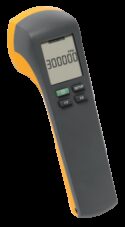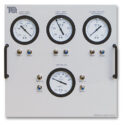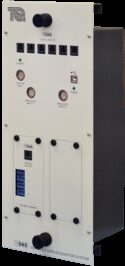Experiment
H83

TWO-STAGE (SERIES AND PARALELL) PUMPS
A compact mobile and fully self-contained two-stage centrifugal pump test set that allows students to clearly and effectively investigate the operating characteristics of a centrifugal pump operating in single series or parallel configurations.
If you have any questions or you'd like to discuss a product, please call us.
+44 1159 722 611TWO-STAGE (SERIES AND PARALELL) PUMPS
A compact, mobile and fully self-contained centrifugal pump test set, that allows students to find the characteristics of centrifugal pumps working alone or in series or parallel. It also allows students to see (and hear) cavitation and understand the use of a Venturi meter and differential pressure measurement to find flow rate.
Two bearing-mounted motors drive each pump independently. The pumps draw water from the integral reservoir. The water travels through strainers and a series of valves to be delivered to a Venturi meter. The water then returns to the reservoir for re-use, keeping water use to a minimum. The pumps each have a transparent ‘window’ so students can see the impeller turning and how the water vapour bubbles form in the pump at cavitation. The optional stroboscope makes the effect easier to see.
Instrument and control modules fit into a frame above and behind the pumps. Each pump has an electronic Motor Drive to control its speed, a load cell to measure torque and a sensor to measure pump speed. A display on each Motor Drive shows speed and torque and automatically calculates and displays true ‘shaft’ power.
The differential pressure across the Venturi gives flow rate. Each pump has its own inlet valve. A two-way valve in the system allows the pumps to work alone, in parallel or in series.
TecQuipment supply a Digital Pressure Display (DP1) as standard, but offer an optional, additional easy-to-read Analogue Pressure Display (AP2). Both instruments display the inlet pressure, delivery pressure and differential pressure across the Venturi. The Analogue Display is more visual, but the Digital Display increases ease of measurement, and allows connection to TecQuipment’s frame-mounted Versatile Data Acquisition System (VDAS-F, available separately). The equipment can use both analogue and digital instrumentation at the same time, allowing students to compare the different pressure measurement methods.
Learning outcomes
- Centrifugal pump performance and characteristics, typically head versus flow and efficiency versus flow
- Non-dimensional performance characteristics
- Flow measurement using a Venturi tube
- Demonstration of cavitation
- Operation of centrifugal pumps in series
- Operation of centrifugal pumps in parallel
















